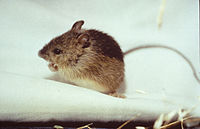MN Wild Animal Management | Mice and Rodent Control
Mice often find their way inside homes as the weather gets cooler and food scarcer. Minnesota’s reputation for bone-chilling weather makes our homes the perfect place for them, especially when it gets colder. You see, it only takes a small crack or hole on the exterior for a small mouse to squeeze their way right in. And as long as they have what they need for survival – food, water, and shelter, mice will begin to rapidly multiply.
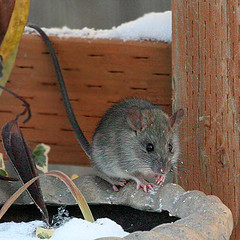 Mice can and do eat through just about anything. If it’s softer than their teeth, the will gnaw their way through. Their front incisor teeth never stop growing and can grow as much as 5 inches in a year’s time. They can jump 12 feet horizontally like a superhero and 12 inches vertically. They don’t require water and thrive in the heat. They have Spiderman-like abilities in scaling vertical surfaces.
Mice can and do eat through just about anything. If it’s softer than their teeth, the will gnaw their way through. Their front incisor teeth never stop growing and can grow as much as 5 inches in a year’s time. They can jump 12 feet horizontally like a superhero and 12 inches vertically. They don’t require water and thrive in the heat. They have Spiderman-like abilities in scaling vertical surfaces.
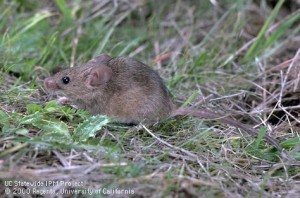
Adult House Mouse-House mice are frequently found in residential households. They lack a white underside and have a relatively hairless tail.
Everyone knows what a mouse is. But not every mouse is a house mouse. Minnesota has many kinds of mice and and close mouse relatives, including voles, lemmings, muskrats, jumping mice, and pocket mice. All are rodents.
Rodents are the most widespread and numerous mammals on earth. Why? Because many rodents are small, they need less food and tinier shelters than big species need. As a rule, small creatures can find more places to live than big ones can. That’s why the world has about 10 times as many species the size of a mouse as it has species the size of a deer.
Squirrels, gophers, porcupines, and beavers are bigger rodents. All rodents have two pairs of incisors with chisel-like edges for gnawing and cutting.
Native Species
Mice
Here are some of Minnesota’s native mice. Biologists classify these mice in the family Muridae.
Northern Grasshopper Mouse
Like little wolves, northern grasshopper mice (Onychomys leucogaster) stake out tiny territories and hunt for food in family “packs.” To communicate with each other, they stand on their hind feet, nose in the air, and call with a high-pitched “howl.” You might say they howl like wolves!
Unlike other mice, males and females form pair bonds and defend the nest and young ones against large intruders, even people. The parents care for the young and bring them food as they grow. Grasshopper mice eat mostly grasshoppers, beetles, and moths–both the insects and insect larvae. They also eat some plants, wasps, flies, spiders, and small mammals. Hunting moving prey takes a lot of skill, so parent mice are thought to take their young out to teach them to find, chase, and capture their food.
Deer Mice
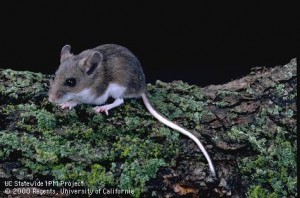
Adult Deer Mouse – Adult deer mouse. Note the large ears and eyes and the white underside of the body and tail—all distinguishing characteristics between the deer mouse and house mouse.
Two species of deer mice live in Minnesota: the white-footed mouse (Peromyscus leucopus) and the deer mouse (P. maniculatus). Both are called deer mice, probably because they are the same color as white-tailed deer–dark above and light below. Both are common throughout Minnesota.
Female white-footed mice carry their young by the backs of their necks to safety, much like a cat carries her kittens. For reasons we don’t understand, white-footed mice sometimes drum on a hollow plant stem or leaf with their front feet to produce a buzzing sound.
Minnesota has two subspecies of P. maniculatus–woodland and prairie. Woodland deer mice are good tree climbers and nest on the ground, in hollow stumps, or under logs. Prairie deer mice nest and stash their food, such as seeds of bush-clover, in underground burrows.
Western Harvest Mouse
These small, uncommon mice scurry around all year, mostly at night, in weeds and grass in southern Minnesota. Western harvest mice (Reithrodontomys megalotis) are excellent climbers, reapers, and weavers. They eat weed and grass seeds, grain, and caterpillars. Harvest mice harvest their food by bending stalks of plants and biting the heads or by gathering seeds from the ground. They often hide food for later.
They weave ball-like grass nests, about the size of a baseball, usually with a single opening, in shrubs or among grasses. Sometimes harvest mice use the abandoned nests of marsh wrens instead of building their own.
Common Voles and Others
While most mice have long tails and large ears and eyes, voles are chunky and usually have small ears and eyes and short tails. Mice are omnivores–they eat both plants and animals. Voles are herbivores–they feed mostly on plants. Minnesota’s voles, lemmings, and the muskrat belong to the Muridae family.
Meadow Vole
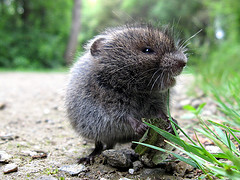
Voles are the easily distinguished from the mice by their short tails and the seeming absence of ears. The ears are there they’re just not very apparent.
Meadow voles (Microtus pennsylvanicus) are an important prey species for hawks and many other animals. Luckily for the predators, lots of meadow voles live throughout most of Minnesota, especially in grasslands, near wetlands, and in grassy woodlands.
Meadow voles eat many greens and seeds, including crops, garden produce, fruits, and the bark of fruit trees. When other food is scarce, they sometimes eat meat.
Active year-round, meadow voles clip grass to create tunnels. In winter, snow covers their tunnels. In spring, when the snow melts, you might see these odd-looking tunnels of dirt and grass on top of your lawn.
Southern Red-Backed Vole
As their name suggests, southern red-backed voles (Clethrionomys gapperi) have reddish-brown fur on their backs. This species is believed to be one of the most abundant mammals in Minnesota’s forests. Many animals prey on them.
Like meadow voles, they are active around the clock. Agile climbers, they cache food–seeds, nuts, fruits, leaves, bark, roots, fungi, and insects. Sometimes they raid caches of squirrels and other mammals.
When frightened, the southern red-backed vole gnashes or chatters its teeth and makes a chirplike bark. It often shows aggressive territorial behavior toward its own kind, as well as toward other mice and voles.
Muskrat
A very common “mouse” is the muskrat (Ondatra zibethicus). It is about five times bigger than most mice and voles. This aquatic rodent swims and dives with ease. Muskrats often build mounds of mud and vegetation in shallow wetlands. These “houses” shelter them and their young from predators and cold.
Southern Bog Lemming
The southern bog lemming (Synaptomys cooperi) is similar in size and appearance to the meadow vole, but with a longer, more grizzled coat and a very short tail. It inhabits woodlands, bogs, and other open, moist areas.
Seldom Seen
The following species are uncommon in Minnesota. Some are at the edge of their range. Others have suffered habitat loss or changes. One–the rock vole–has been expanding its range. All but the rock vole are listed as species of special concern.
Rock Vole
Sometimes called yellow-nosed voles, rock voles (Microtus chrotorrhinus) live only in the northeastern corner of Minnesota. They eat insects, fungi, grasses, and other plants. They prefer to live in forests with a lot of moss-covered boulders, scurrying around in subterranean runways and between rocks.
Woodland, Eastern Heather, and Prairie Voles
Woodland voles (M. pinetorum) live in the far southeastern tip of Minnesota, where they burrow into the soil and leaf litter. At the opposite end of the state, in the far north, eastern heather voles (Phenacomys ungava) are just as uncommon, living near the Canadian border at the southernmost part of their range. Neither of these animals has ever been numerous in the state. On the other hand, prairie voles (M. ochrogaster) used to be abundant here before the prairie all but disappeared with farming and settlement. Now the prairie vole is very rare. It survives only in isolated pockets of remnant prairie.
Northern Bog Lemming
Not much is known about the northern bog lemming (Synaptomys borealis), although it closely resembles Minnesota’s other lemming, S. cooperi, using similar habitats, behaving in similar ways, and looking very much the same. Uncommon to rare throughout its range in Canada, it has always been rare in Minnesota.
Winter Hibernators
Minnesota is also home to two other families of native mice–the family Zapodidae, to which the jumping mice belong, and the family Heteromyidae, to which the plains pocket mouse belongs. Although these families are very different, they share a common trait: They hibernate.
Jumping Mice
Two species of jumping mice live in Minnesota: the meadow jumping mouse (Zapus hudsonius) and the less common woodland jumping mouse (Napaeozapus insignis). The meadow jumping mouse ranges throughout Minnesota. The woodland jumping mouse stays in the woods of northeastern Minnesota.
With their long hind feet and the longest tail of any Minnesota mouse, they can jump more than three feet to avoid danger. They are also good swimmers and divers. But the main way they avoid predators is by standing very still.
Jumping mice eat fruits, seeds, fungi, and insects. They hibernate underground in nests of grass and leaves.
Plains Pocket Mouse
These tiny nocturnal mice once lived on Minnesota’s dry, sandy prairies. Plains pocket mice (Perognathus flavescens) have long tails and long hind feet, though not as long as those of jumping mice. They hibernate but awaken occasionally to nibble away at their stored foods.
Plains pocket mice have external cheek pouches, like those of pocket gophers. They stuff seeds and grain in their fur-lined pouches and carry the food to their underground caches. Once there, they force out the contents by pressing against their pouches with their front feet.
Pocket mice rarely drink water. Instead, they get water from the food they digest. This adaptation makes the plains pocket mouse suited to living in dry places such as prairies.
Nonnative Species
Sharing Human Habitat
House mice and Norway rats also belong to the family Muridae. Murids are some of the most widespread mammals on earth. From central and southeastern Asia, house mice and Norway rats spread to Europe, then jumped aboard ships and eventually landed in North America. As uninvited house guests, these mice and rats may become pests.
House Mouse
House mice (Mus musculus) live in houses and other buildings and farm fields throughout North America. You can tell them apart from native mice by their almost furless ears and scaly tails.
House mice eat seeds, crops, insects, and even such things as soap and glue. They are good climbers, swimmers, and jumpers. They can run as fast as 8 miles per hour. Even so, they seldom travel farther than 50 feet from their homes. House mice are kept as pets and research laboratory animals.
Norway Rat
The Norway rat (Rattus norvegicus) is a nonnative species with a long, scaly, nearly hairless tail. Like all rodents, it carries lice and fleas. Living among humans (and their garbage), rats can increase to large numbers. Then their eating and gnawing can destroy property such as stored grains and electrical wires.
Guard Your Home From Furry Guests This Winter!
Keep in mind, the key to winter pest control is prevention. To stop mice and other creepy critters from taking up residence in your home, reduce the appealing elements from and around your home. And if you’ve done everything you can do and still have a mice problem, contact a Minnesota Wild Animal Management Expert to get rid of these rodents once and for all as well as repair any damage they may have caused.
Continued: Mice, Mouse Rodent Control & Removal Minneapolis MN Part 2

